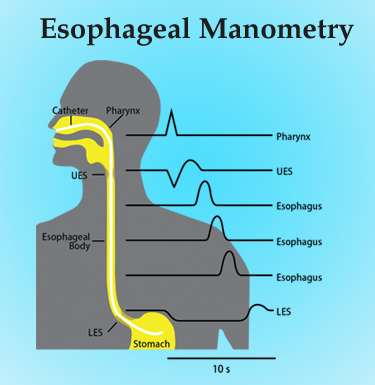Esophageal Manometry

What is a Esophageal Manometry?
In esophageal manometry a small flexible tube is passed from one of your nostril in to the esophagus and stomach to measure the function and strength of esophagus and lower esophageal sphincter (the
valve that prevents reflex of gastric acid into the esophagus).This procedure does not interfere with your breathing. In procedure room you will be allowed to lie down on procedure bed. A small flexible tube
will be passed from your nostril. After adjusting the tube, it will be fixed by a sticking from outside. For 10 min you will be allowed to lie down after fixation of the tube, so that you get used to the tube. The tube is connected to a machine that records the contraction of the esophageal muscles on a graph. You may feel some discomfort as the tube is being placed, but it takes only about a minute to place. During
the test you will be asked to swallow water at certain times. The test lasts for 30-40 minutes.
WHAT ACTUALLY HAPPENS IN OESOPHAGEAL MANOMETRY?
Please do not come to the hospital wearing or carrying valuables. You may be asked to change your
clothing and given a cap to tuck all your hairs into. You may leave your belongings, your dentures,
hearing aids, glasses and contact lens in a secure locker provided by us, the key of which will remain
with you or your relation till you leave.
At first our nursing staff will review all your previous medical records. They will ask you the last time you
had anything to eat or drink and if you have any allergies. They will ask about special needs or concerns.
You will lie on a stretcher in the procedure room. Safety devices will be kept to keep you safe,
comfortable and secure throughout your procedure. After the procedure you will have privacy to change
and tidy up. Your esophageal manometry report will be made available as soon as possible, and you can
discuss your findings with your doctor.
ARE THERE ANY RISKS IN THE PROCEDURE?
Food in the stomach may get inhaled into the lungs, thus we prefer to call patient fasting in the morning.
If you are taking any medication daily on regular basis (like diabetes, blood pressure, heart ailments)
please discuss the timing of the doses with your doctor.
Please remove your dentures before the procedure. If dislodged during the procedure they may
accidentally come into your airway and obstruct your breathing. There is a very small risk of dental
crowns or bridge work may be damaged.
WARE THERE ANY OTHER WAYS TO GET SAME INFORMATION?
This test is the only way to find out the function and strength of esophagus. During esophageal
manometry the doctor can directly look at the specific area to better evaluate and detect problem.
All major hospitals have stringent protocols for sterilization, and we assure that all aseptic precautions are in place to prevent transmission of infection during the procedure.
INDICATIONS:
- Evaluation of patients with hiatus hernia, for customizing decisions about continuing medical
treatment and decisions about surgery. - Evaluation of non cardiac chest pain or oesophageal symptoms not diagnosed on endoscopy.
- Evaluation of achalasia or another type of non obstructive dysphagia.
- Evaluation of esophageal motility problems associated with systemic diseases.
The procedure could be challenging in the following situations::
- Patient with altered mental status.
- Known pharyngeal or upper esophageal obstruction (eg tumor).
- Impaired hearing.
PRE PREPARATION FOR TEST
You need to fast for at least 4 hrs before the test; If u have test in morning do not eat or drink after midnight.
POST TEST:
As you will not need sedation for this examination, you are free to eat whatever you wish immediately after the test, you may also leave for work immediately. You should receive the report in 10-20 minutes following the end of the test.
